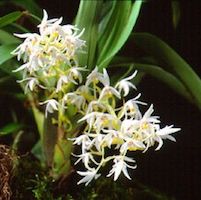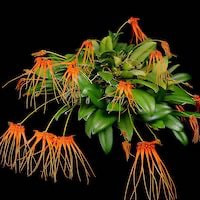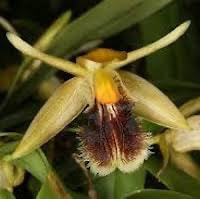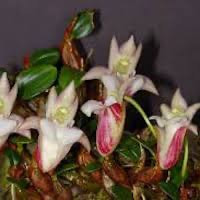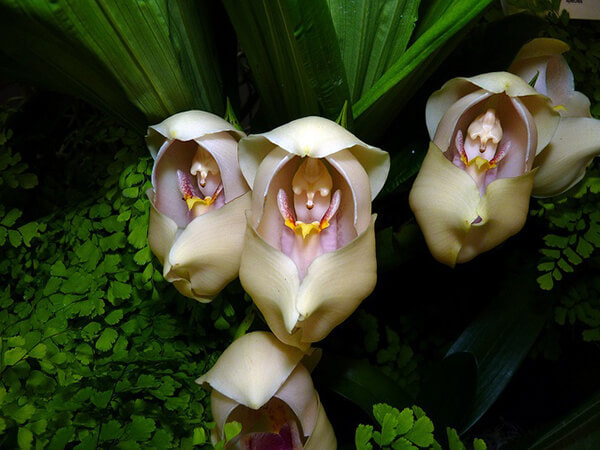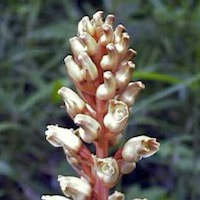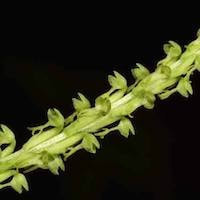Elevate Your Senses with Floral 8 Fragrance Oil
The scent compositions feature a variety of scented notes derived from different orchid species. One of these is Eria Javanica, also known as the Javanese Eria or Xiang Hua Mao Lan in China. This orchid thrives in warm-to-cool climates and produces exquisite star-shaped, creamy yellow flowers on graceful arching spikes. Its pleasant scent makes it a popular choice in gardens and orchid farms.
Another orchid contributing to the fragrance blend is Bulbophyllum pectenveneris, referred to as Huanghuajuanban Lan or Huanghuashitou Lan in Chinese. This orchid is believed to possess properties that improve circulation and alleviate pain in joints, muscles, and bones. Its scented notes add depth and character to the overall fragrance composition.
Coelogyne fimbriata Lindl., known as Liusubeimu Lan in Chinese and Ngwe hnin phyu myo kywe in Myanmar, offers its scented notes to the fragrance blend. This orchid is utilized in traditional Chinese herbal medicine to reduce heat, further enriching the aromatic profile of the perfume.
Dendrobium fargesii Finet, with its various Chinese names like Danyehouchun Lan and Shiduo, contributes its scented notes to the fragrance composition. This orchid is valued in herbal medicine for its ability to clear heat, moisten dryness, and address respiratory conditions such as coughs and sore throats.
Eulophia ochreata Lindl., also known as Amarkand or Singadyakand in Indian culture, is an endemic terrestrial orchid found in Peninsular India. Its tubers are utilized in traditional medicine for their anti-inflammatory effects. The scented notes of this orchid enhance the fragrance blend, adding a unique element to the perfume.
Gastrodia elata Blume, commonly known as Tianma or Heaven's Fibre, has a rich history in Traditional Chinese Medicine. It is sought after for its effects on various conditions such as frightfulness, headaches, blood circulation, and rheumatic conditions. The scented notes from Gastrodia elata contribute to the aromatic profile, providing a distinctive scent to the perfume.
Herminium lanceum, also known as Shuangchunjiaopan Lan in Chinese, thrives in forested areas and grassy slopes. Its root is believed to have benefits for the lung, kidney, and musculoskeletal system. The scent notes from Herminium lanceum further enrich the fragrance blend, adding complexity and depth.
In addition to these orchid scents, the perfume compositions incorporate other scent notes such as English Marigold, Freesia, Geranium, Mimosa, Heather, Narcissus, Pansy, Rose hip, Safflower, Violet, and Jasmine. These additional scents contribute to the overall fragrance, creating a diverse range of aromas that provide a unique olfactory experience.
Another orchid contributing to the fragrance blend is Bulbophyllum pectenveneris, referred to as Huanghuajuanban Lan or Huanghuashitou Lan in Chinese. This orchid is believed to possess properties that improve circulation and alleviate pain in joints, muscles, and bones. Its scented notes add depth and character to the overall fragrance composition.
Coelogyne fimbriata Lindl., known as Liusubeimu Lan in Chinese and Ngwe hnin phyu myo kywe in Myanmar, offers its scented notes to the fragrance blend. This orchid is utilized in traditional Chinese herbal medicine to reduce heat, further enriching the aromatic profile of the perfume.
Dendrobium fargesii Finet, with its various Chinese names like Danyehouchun Lan and Shiduo, contributes its scented notes to the fragrance composition. This orchid is valued in herbal medicine for its ability to clear heat, moisten dryness, and address respiratory conditions such as coughs and sore throats.
Eulophia ochreata Lindl., also known as Amarkand or Singadyakand in Indian culture, is an endemic terrestrial orchid found in Peninsular India. Its tubers are utilized in traditional medicine for their anti-inflammatory effects. The scented notes of this orchid enhance the fragrance blend, adding a unique element to the perfume.
Gastrodia elata Blume, commonly known as Tianma or Heaven's Fibre, has a rich history in Traditional Chinese Medicine. It is sought after for its effects on various conditions such as frightfulness, headaches, blood circulation, and rheumatic conditions. The scented notes from Gastrodia elata contribute to the aromatic profile, providing a distinctive scent to the perfume.
Herminium lanceum, also known as Shuangchunjiaopan Lan in Chinese, thrives in forested areas and grassy slopes. Its root is believed to have benefits for the lung, kidney, and musculoskeletal system. The scent notes from Herminium lanceum further enrich the fragrance blend, adding complexity and depth.
In addition to these orchid scents, the perfume compositions incorporate other scent notes such as English Marigold, Freesia, Geranium, Mimosa, Heather, Narcissus, Pansy, Rose hip, Safflower, Violet, and Jasmine. These additional scents contribute to the overall fragrance, creating a diverse range of aromas that provide a unique olfactory experience.
Download the guided mediation that works best with this Orchid fragrance oil
| women_floral_essential_oil_orchi_00008.mp3 | |
| File Size: | 115217 kb |
| File Type: | mp3 |
The Power of Orchids Unleashed
Contains Scented Notes of following in various proportions:
Native Singaporean Orchid notes: Eria Javanica
|
Eria Javanica - Used in Floral 8 (Women) for Team building Perfume workshop
Eria Javanica, also known as the Javanese Eria or Xiang Hua Mao Lan in China, is widely spread throughout Asia due to its ability to thrive in warm-to-cool climates. This orchid species is highly valued for its scent and is commonly used in perfumery, including the Floral 8 (Women) perfume specifically designed for team-building perfume workshops. The Javanese Eria is a popular choice in gardens and orchid farms because of its year-round flowering capability. It showcases stunning star-shaped flowers in a delicate shade of creamy yellow. These beautiful flowers are densely packed onto a graceful, arching spike, creating an enchanting visual display. In terms of scent, the Javanese Eria is known for its captivating fragrance. The specific aroma profile of this orchid species adds a unique and alluring note to perfumes. Its scent is often described as pleasing, delicate, and evocative, making it a popular choice for fragrance blends. Given its widespread distribution, adaptability to various climates, and appealing scent, the Javanese Eria has become one of the most common orchid species found in gardens and orchid farms across Asia. Its inclusion in the Floral 8 perfume for team-building perfume workshops demonstrates its significance and desirability in the fragrance industry. |
Therapeutic Orchid notes:
|
Bulbophyllum pectenveneris
Chinese name: Huanghuajuanban Lan (yellow flower folding petal orchid), Huanghuashitou Lan (yellow flower stone bean orchid) Bulbophyllum pectenveneris, also known as Huanghuajuanban Lan or Huanghuashitou Lan in Chinese, is an orchid species known for its unique scent and medicinal properties. In Chinese traditional medicine, the entire plant of Bulbophyllum pectenveneris is believed to possess therapeutic qualities. It is reputed to have the ability to improve circulation and alleviate pain in the joints, muscles, and bones. This orchid species is valued for its potential analgesic and anti-inflammatory properties. The specific scent profile of Bulbophyllum pectenveneris is distinct and contributes to its overall appeal. While the exact aroma description may vary, it is often described as pleasant, aromatic, and captivating. The scent adds an intriguing note to fragrance compositions, making it a valuable ingredient in perfumery. Due to its therapeutic properties and alluring fragrance, Bulbophyllum pectenveneris is highly regarded in both traditional medicine and the fragrance industry. Its inclusion in perfumes and scented products highlights its potential to enhance the olfactory experience while providing potential benefits for circulation and pain relief. |
|
Coelogyne fimbriata Lindl.
Chinese name: Liusubeimu Lan (tassels pearl shell orchid) Myanmar name: Ngwe hnin phyu myo kywe Coelogyne fimbriata, commonly known as Liusubeimu Lan in Chinese and Ngwe hnin phyu myo kywe in Myanmar, is an orchid species known for its distinct scent and potential medicinal properties. In Chinese herbal medicine, Coelogyne fimbriata is highly valued for its cooling properties. The whole plant is used to reduce heat within the body. It is believed to have a cooling effect on the system, helping to balance internal temperature and provide relief from heat-related conditions. The specific scent profile of Coelogyne fimbriata is unique and contributes to its overall allure. While the exact aroma description may vary, it is often described as pleasant, floral, and refreshing. The fragrance adds a delightful note to perfumes and scented products, enhancing the olfactory experience. Coelogyne fimbriata is found in various regions including Hainan, Guangdong, Yunnan, and Xizang. Its availability in these areas contributes to its use in traditional herbal practices. The combination of its medicinal usage and appealing scent makes Coelogyne fimbriata a valuable ingredient in both traditional medicine and perfumery. Its inclusion in fragrances adds a touch of freshness while potentially providing therapeutic benefits. |
|
Dendrobium fargesii Finet. syn. Epigeneium fargesii (Finet) Gagnep
Chinese names: Danyehouchun Lan (single leaf, thick-lipped orchid), Maihu (wheat Dendrobium); Guoshangye (leaf above fruit); Shiduo (stone bean); Danyeshizao (single leaf stone date); Shi Lan (stone olive) Taiwanese name: Lian Zhu Lan (chain of pearls orchid), Xiao Pan Long (coiled dragon) San Xing Shi Hu (three stars Dendrobium) Dendrobium fargesii, also known as Danyehouchun Lan, Maihu, Guoshangye, Shiduo, Danyeshizao, and Shi Lan in Chinese, and Lian Zhu Lan, Xiao Pan Long, and San Xing Shi Hu in Taiwanese, is an orchid species known for its therapeutic properties and unique scent. In traditional herbal usage, the entire plant of Dendrobium fargesii is employed for its medicinal benefits. It is believed to have the ability to clear heat and moisten dryness within the body. This orchid is used in the treatment of various respiratory conditions, including tuberculous cough, bronchitis, pneumonia, and sore throat. It is also utilized to relieve symptoms such as phlegm and coughs. Additionally, Dendrobium fargesii is known to be effective in treating gastritis, knife wounds, and night sweats. The scent of Dendrobium fargesii is captivating and adds to its overall appeal. While the exact fragrance profile may vary, it is often described as pleasant, floral, and soothing. The aroma enhances the olfactory experience and contributes to the overall composition of perfumes and scented products. The various names given to this orchid species reflect its significance in Chinese and Taiwanese cultures. Its medicinal usage and appealing scent make it a valuable ingredient in traditional medicine and perfumery alike. Dendrobium fargesii is recognized for its therapeutic effects, clearing heat, and providing relief from respiratory ailments. Its distinct scent, combined with its medicinal properties, makes it a sought-after component in fragrances and an important herb in traditional practices. |
|
Eulophia ochreata Lindl.
Indian names: Amarkand, Singadyakand Description: It is a pseudobulbous, terrestrial orchid, endemic in Peninsular India. Phytochemistry: A phenanthrene, 9,10-dihydro- 2,5-methoxyphenanthrene-1,7-diol isolated from the tubers is anti-inflammatory. The phenanthrene, remarkably did not interfere with any cellular process. Herbal Usage: Tubers are used for a variety of conditions in Mumbai. The juice is applied externally to treat rheumatism. Tubers have a high mineral content exceeding 2 % of dry weight and are eaten as a traditional vegetable. In Rajasthan, India, powdered pseudobulbs are mixed with powdered tubers of Chlorophytum borivilianum in equal proportions and a teaspoon of the mix dissolved in milk is consumed daily for a month to boost the immune system. Tuber powder is also administered to patients with leukemia. Tubers are also used as aphrodisiac, and “blood purifier”, to treat |
|
Gastrodia elata Blume
Local Name: Tianma (Heaven’s fibre, Sky burlap) Other Common Names: Chinese: Ming Tianma (Bright heaven’s fibre); Chi Jian (Crimson arrow); Chijiangen (Red arrow root); Ding Feng Cao (Wind-calming herb); Bai Long Pi (White dragon skin); Bailongcao (White dragon grass) Japanese name: Tenma (Heaven’s fibre); Oni-no- yagara (Orge’s arrow) Korean name: Cheon ma Flowering season is May to July all over China. Tuber of this orchid is one of the oldest drugs in Traditional Chinese Medicine (TCM). The records date only to the Han Dynasty (221 BC–220). Its original name was Chi Jian (Red arrow). The current name, Tianma (Heaven’s fibre), was first mentioned during the Song Dynasty (960-1279) in Kai Bao Bencao published in 973. The relationship of G. elata to fungi Armillaria mellea (honey fungus) is quite complex in the natural setting and not restricted to Armillaria. It is used for For frightfulness of children, For stroke, tetanus, for migraine and various forms of headaches, For malaise, dizziness, sleepiness, headaches For excessive liver yang, surge of liver wind, headaches, dizziness, insomnia For high blood pressure For postpartum blood circulation For stroke with paralysis of extremities For rheumatism with stiffness of extremities in women For backache and pain of the lower extremities For rheumatism, numbness and paralysis For lung “wind poison”, pruritus and skin boils and ulcers For generalized dermatitis Phytochemistry: To date, 47 compounds, of which the majority were phenols, have been isolated from G. elata. On Skin Pigmentation - Korean, Chinese and other Asian scientists are screening medicinal plants for tyrosinase and DOPA auto-oxidation inhibitory activities to possibly employ them as skin whiteners in the cosmetic industry. |
|
Herminium lanceum (Thunb. ex Sw.) Vuijk
Chinese names: Shuangchunjiaopan Lan (two lips, angle plate orchid), Shuangshencao (two kidney grass), Chachunjiaopan Lan Chinese medicinal name: Yaozicao It is a terrestrial herb, thriving among grasses in forests, thickets and grassy slopes, and among rocks at 1100–3500 m. It flowers from June to August or September in mainland China, April to September in Taiwan, July to August in Sikkim, July to October in Bhutan and June to August in Nepal. Herb is obtained from Shandong to Tibet and from Dongbei (Northeast China, Manchuria) to Guangxi and Taiwan. Herbal Usage: The root is said to benefit the lung; it is used to treat tuberculosis. It also benefits the kidney, strengthens the muscles and bones and stops bleeding. The decoction is prepared with 6–15 g of the herb. In India, it enjoys usage as a nutrient or a tonic. |
Other scent note
English Marigold, Freesia, Geranium, Mimosa, Heather, Narcissus, Pansy, Rose hip, Safflower, Violet, Jasmin
Scentopia Library Reference ingredient
Rose - Check details at Scentopia's scent library
Join Scentopia's wonderful orchid scent crafting, fragrance tour, bridal shower or corporate team building which includes perfume making onsite and offsite, beach activities and more. We also serve primary school learning journey, secondary students and pupil on industrial excursions. Know more about our orchids perfume bar or therapeutic orchid scents and other wellness aromas. Conatct Perfume workshop or book a scent crafting session here.
